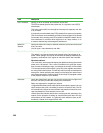115
www.gateway.com
Security considerations related to WDS bridges
Static Wired Equivalent Privacy (WEP) is a data encryption protocol for 802.11 wireless
networks. Both access points in a given WDS link must be configured with the same
security settings. For static WEP, either a static 64-bit (40-bit secret key + 24-bit initialization
vector (IV)) or 128-bit (104-bit secret key + 24-bit IV) Shared Key is specified for data
encryption.
You can enable Static WEP on the WDS link (bridge). When WEP is enabled, all data
exchanged between the two access points in a WDS link is encrypted using a fixed WEP
key that you provide.
Static WEP is the only security mode available for the WDS link, and it does not provide
effective data protection to the level of other security modes available for service to client
stations. If you use WDS on a LAN intended for secure wireless traffic you are putting your
network at risk. Therefore, we recommend using WDS to bridge the guest network only
for this release. Do not use WDS to bridge access points on the internal network unless
you are not concerned about the security risk for data traffic on that network.
For more information about the effectiveness of different security modes, see “Configuring
network security” on page 80. This topic also covers use of plain text security mode for
AP-to-station traffic on the guest network, which is intended for less sensitive data traffic.
Navigating to WDS settings
To specify the details of traffic exchange from this access point to others, click Advanced
> Wireless Distribution System
on the Administration Web page. The Configure WDS bridges
to other access points screen opens. Update the boxes as described in the following section.


















